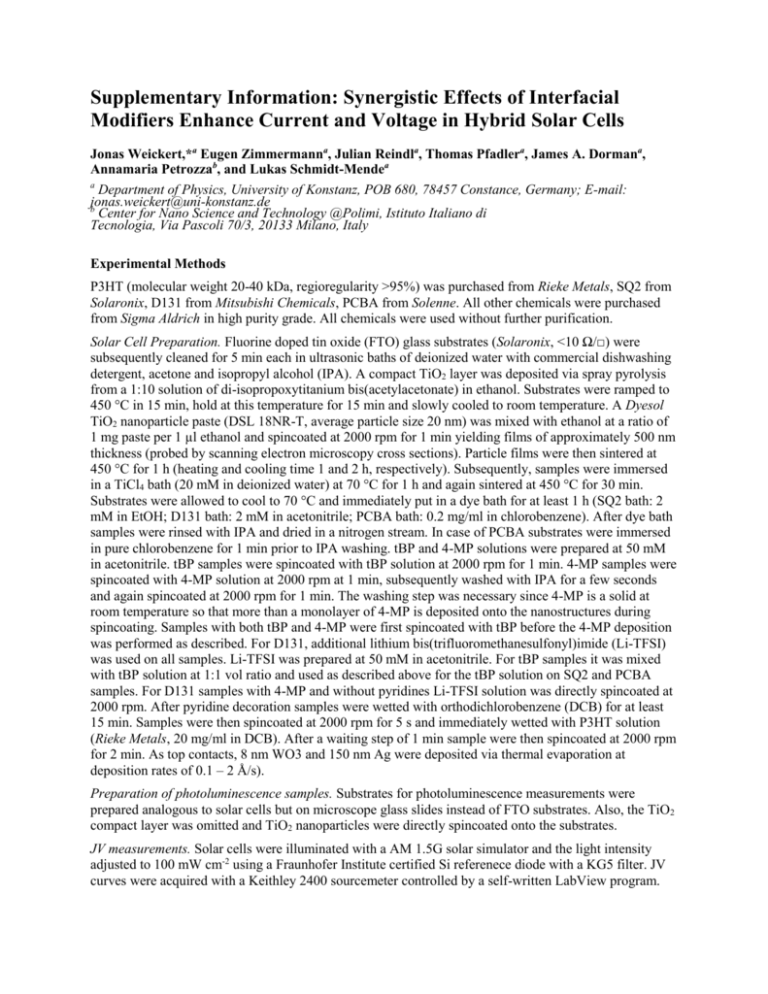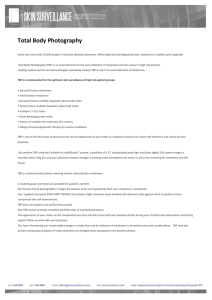4-MP Supplementary Information v5.0 Plain Text
advertisement

Supplementary Information: Synergistic Effects of Interfacial Modifiers Enhance Current and Voltage in Hybrid Solar Cells Jonas Weickert,*a Eugen Zimmermanna, Julian Reindla, Thomas Pfadlera, James A. Dormana, Annamaria Petrozzab, and Lukas Schmidt-Mendea a Department of Physics, University of Konstanz, POB 680, 78457 Constance, Germany; E-mail: jonas.weickert@uni-konstanz.de b Center for Nano Science and Technology @Polimi, Istituto Italiano di Tecnologia, Via Pascoli 70/3, 20133 Milano, Italy Experimental Methods P3HT (molecular weight 20-40 kDa, regioregularity >95%) was purchased from Rieke Metals, SQ2 from Solaronix, D131 from Mitsubishi Chemicals, PCBA from Solenne. All other chemicals were purchased from Sigma Aldrich in high purity grade. All chemicals were used without further purification. Solar Cell Preparation. Fluorine doped tin oxide (FTO) glass substrates (Solaronix, <10 Ω/□) were subsequently cleaned for 5 min each in ultrasonic baths of deionized water with commercial dishwashing detergent, acetone and isopropyl alcohol (IPA). A compact TiO2 layer was deposited via spray pyrolysis from a 1:10 solution of di-isopropoxytitanium bis(acetylacetonate) in ethanol. Substrates were ramped to 450 °C in 15 min, hold at this temperature for 15 min and slowly cooled to room temperature. A Dyesol TiO2 nanoparticle paste (DSL 18NR-T, average particle size 20 nm) was mixed with ethanol at a ratio of 1 mg paste per 1 µl ethanol and spincoated at 2000 rpm for 1 min yielding films of approximately 500 nm thickness (probed by scanning electron microscopy cross sections). Particle films were then sintered at 450 °C for 1 h (heating and cooling time 1 and 2 h, respectively). Subsequently, samples were immersed in a TiCl4 bath (20 mM in deionized water) at 70 °C for 1 h and again sintered at 450 °C for 30 min. Substrates were allowed to cool to 70 °C and immediately put in a dye bath for at least 1 h (SQ2 bath: 2 mM in EtOH; D131 bath: 2 mM in acetonitrile; PCBA bath: 0.2 mg/ml in chlorobenzene). After dye bath samples were rinsed with IPA and dried in a nitrogen stream. In case of PCBA substrates were immersed in pure chlorobenzene for 1 min prior to IPA washing. tBP and 4-MP solutions were prepared at 50 mM in acetonitrile. tBP samples were spincoated with tBP solution at 2000 rpm for 1 min. 4-MP samples were spincoated with 4-MP solution at 2000 rpm at 1 min, subsequently washed with IPA for a few seconds and again spincoated at 2000 rpm for 1 min. The washing step was necessary since 4-MP is a solid at room temperature so that more than a monolayer of 4-MP is deposited onto the nanostructures during spincoating. Samples with both tBP and 4-MP were first spincoated with tBP before the 4-MP deposition was performed as described. For D131, additional lithium bis(trifluoromethanesulfonyl)imide (Li-TFSI) was used on all samples. Li-TFSI was prepared at 50 mM in acetonitrile. For tBP samples it was mixed with tBP solution at 1:1 vol ratio and used as described above for the tBP solution on SQ2 and PCBA samples. For D131 samples with 4-MP and without pyridines Li-TFSI solution was directly spincoated at 2000 rpm. After pyridine decoration samples were wetted with orthodichlorobenzene (DCB) for at least 15 min. Samples were then spincoated at 2000 rpm for 5 s and immediately wetted with P3HT solution (Rieke Metals, 20 mg/ml in DCB). After a waiting step of 1 min sample were then spincoated at 2000 rpm for 2 min. As top contacts, 8 nm WO3 and 150 nm Ag were deposited via thermal evaporation at deposition rates of 0.1 – 2 Å/s). Preparation of photoluminescence samples. Substrates for photoluminescence measurements were prepared analogous to solar cells but on microscope glass slides instead of FTO substrates. Also, the TiO2 compact layer was omitted and TiO2 nanoparticles were directly spincoated onto the substrates. JV measurements. Solar cells were illuminated with a AM 1.5G solar simulator and the light intensity adjusted to 100 mW cm-2 using a Fraunhofer Institute certified Si referenece diode with a KG5 filter. JV curves were acquired with a Keithley 2400 sourcemeter controlled by a self-written LabView program. For light intensity dependent measurements light intensity was reduced using neutral density filters. Solar cells were placed in a light tight metal box (in order to avoid additional excitation of the materials due to scattered light) and illuminated through a shadow mask defining an active area of 0.125 cm2. IPCE measurements. IPCE was measured using the same solar cell holder and shadow mask. As illumination source a 150 W Xe lamp was used in combination with a monochromator. Monochromatic light was focused on the solar cell with a spot size larger than the active area of the device. Since our setup performs IPCE measurements without a white light background acquired spectra were normalized to the short circuit current density under 100 mW cm-2 solar illumination in order to avoid overestimation of the IPCE, i.e., the spectra were corrected by the quotient of measured short circuit current density and the short circuit current density under 1 sun illumination estimated from the IPCE measurement by convolution of the IPCE curve with an AM 1.5G spectrum. Impedance spectroscopy measurements. Impedance spectra were recorded with an Autolab potentiostat/galvanostat. The tested device was put in a light-tight grounded metal box and illuminated with a white light diode. The diode intensity was set to approximately 100 mW cm-2 using a silicon reference diode. Measurements were performed at a DC bias of 0 V with a small AC perturbation using frequencies between 1 Hz and 1 MHz and an amplitude of 10 mV, which is well below the thermal voltage at room temperature. ηcoll measurements. In order to determine the charge collection efficiency ηcoll photocurrent decay (PCD) and photovoltage decay (PVD) curves were measured. An AM 1.5G solar simulator was adjusted to approximately 100 mW/cm2 and focused onto the tested device as background light source. A small perturbation was generated with a pulsed laser (532 nm, approximately 5 mW cm-2, ns pulses, repetition rate 18 Hz) and the signal was acquired with a digital oscilloscope. For PVD measurements, the solar cell was operated at quasi-open circuit by measuring the potential drop over the oscilloscope’s 1 MΩ termination resistance. PCD curves were determined via Ohm’s law from measurements across the 50 Ω termination resistance of the oscilloscope. Since PVD/PCD measurements are performed at small perturbations the data can be fitted with single exponentials as described in the literature.1 From the resulting decay rates kPVD and kPCD the charge collection efficiency ηcoll was estimated as ηcoll= kPCD/(kPVD∙kPCD) in accordance with literature.2 Photoluminescence measurements. Photoluminescence (PL) spectra were recorder with a Horiba FluoroLog Spectrometer. As illumination source a 350 W Xe lamp in combination with a double monochromator is used and focused onto the sample under an angle of 60°. The emitted spectra are recorded under an angle of 30° through a second double monochromator with a photodetector and spectra are corrected for the detector’s quantum efficiency and the excitation light intensity. Chemical Structures of Dye Molecules Figure SF1. Chemical structures of dye molecules used in this study. Solar Cell Performance The following table summarizes JV measurement parameters for solar cells fabricated with the three different dye molecules SQ2, D131 and PCBA and different pyridines. The data represents values of typical devices, not champion devices. All solar cells are fabricated within one batch in one experiment to assure direct comparability of the results. Table TS1. JV characteristics for solar cells with SQ2, D131 and PCBA as sensitizer and different pyridine configurations. SQ2 No pyridine tBP 4-MP 4-MP + tBP PCE (%) 1.30 1.24 1.63 1.81 D131 No pyridine tBP 4-MP 4-MP + tBP PCE (%) 1.03 1.36 1.23 1.61 VOC (V) PCBA No pyridine tBP 4-MP 4-MP + tBP PCE (%) 0.38 0.50 0.54 0.54 VOC (V) JSC (mA/cm2) 4.32 3.09 4.75 4.59 FF (%) FF (%) 551 712 647 704 JSC (mA/cm2) 3.14 3.16 3.27 3.38 FF (%) 391 502 421 492 JSC (mA/cm2) 1.88 1.74 2.18 2.05 VOC (mV) 546 663 596 643 55.2 60.5 57.6 61.6 60.0 60.7 58.1 68.1 51.3 57.9 58.6 54.1 Impedance Spectroscopy Data Modeling Impedance spectra were fitted with an equivalent circuit similar to the model used by Zhang et al. but extended by one parallel combination of a constant phase element (CPE) and a resistor. These additional elements were necessary to get consistently good fit results for the four different pyridine configurations and is attributed to contact between P3HT, WO3 and Ag and the bulk of P3HT since the capping layer thickness was not optimized in our experiments and is probably thicker than necessary. A schematic of the equivalent circuit is shown in the main article. For all fits a fixed length of 100 CPE-R elements was used. Data modeling is done using the software ZView and fit results are summarized in the following table. Table TS2. Fit parameters and uncertainties as found using ZView and the described equivalent circuit with 100 CPE-R elements. CB (nC) nB RB (Ω) RT (Ω) Cµ (nC) nµ RCT (kΩ) No pyridine 8.56 ± 1.41 0.883 ± 0.019 152.2 ± 11.6 0.132 ± 0.023 55.09 ± 3.24 0.574 ± 0.008 181.1 ± 2.7 tBP 12.20 ± 1.52 0.970 ± 0.017 146.2 ± 8.7 0.185 ± 0.027 46.55 ± 2.31 0.571 ± 0.007 244.1 ± 2.9 4-MP 4.80 ± 0.28 0.877 ± 0.008 269.3 ± 6.1 0.558 ± 0.027 9.90 ± 0.44 0.740 ± 0.005 417.7 ± 5.6 4-MP + tBP 3.76 ± 0.20 0.872 ± 0.007 338.2 ± 7.4 0.337 ± 0.022 5.50 ± 0.27 0.787 ± 0.006 400.7 ± 5.3 Photoluminescence Measurement. Photoluminescence spectra for P3HT on SQ2-sensitized TiO2 nanoparticle films with different pyridines are shown in figure FS2. Figure FS2. Photoluminescence emission spectra for TiO2 nanoparticle films with SQ2, pyridines and P3HT. Emission is normalized to the excitation light intensity and proportional to the logarithm of the detector’s photon counts but in arbitrary units. Features at doubled and tripled excitation wavelength are artifacts and no data is acquired for emission wavelengths smaller than the respective excitation wavelength. Photovoltage and Photocurrent Decay Results Decay rates from exponential fits of photovoltage decay (PVD) and photocurrent decay (PCD) measurements and calculated charge carrier collection efficiencies are summarized in table TS3. Table TS3. Decay rates and calculated charge collection efficiencies from PVD/PCD measurements. kPCD (1/s) kPVD (1/s) ηcoll (%) No pyridine 140426 23509 85.7 tBP 340655 28725 92.2 4-MP 298737 25789 92.1 4-MP + tBP 269086 28422 90.4 References 1 2 CG Shuttle, B. O’regan, AM Ballantyne, J. Nelson, DDC Bradley, J. De Mello, and JR Durrant, Applied Physics Letters 92, 093311 (2008). L. Luo, C.J. Lin, C.S. Hung, C.F. Lo, C.Y. Lin, and E.W.G. Diau, Phys. Chem. Chem. Phys. 12 (40), 12973 (2010).







